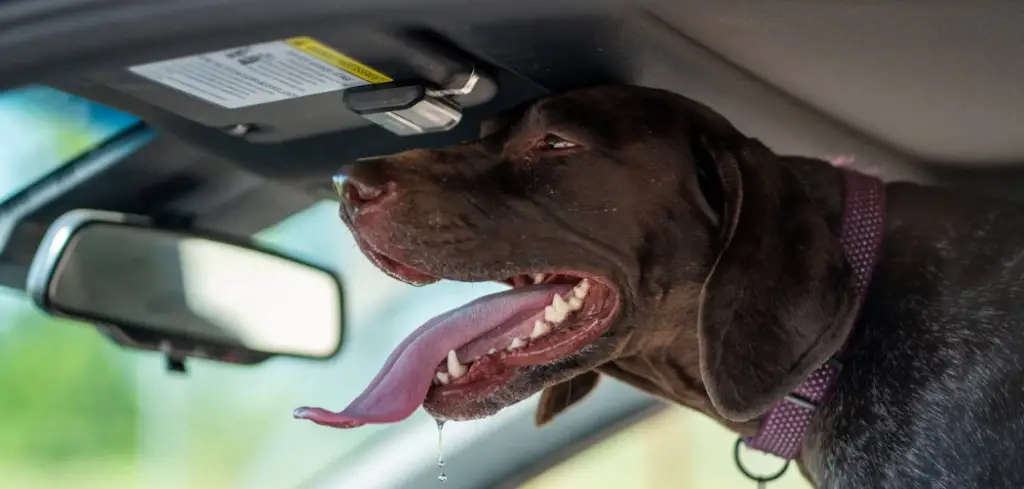Seeing your dog panting and yawning while in the car can be concerning, especially if it seems out of the ordinary. These behaviors often indicate stress or other underlying issues that need attention.
We outline the common reasons why dogs may pant and yawn in the car, what you can do at home, and when to seek veterinary help.
Dog Panting and Yawning in Car — Why It Happens
When a dog pants and yawns in the car, it’s often linked to stress, anxiety, or motion sickness. Panting is a way for dogs to regulate their body temperature but can also show nervousness, while yawning is a common calming signal that dogs use when they feel uneasy.
Some dogs may get carsick, which adds to their discomfort. If this happens frequently, it’s usually more about anxiety than illness, though in some cases motion sickness or overheating could play a role.

Dog Panting and Yawning in Car: Common Causes
Travel Anxiety
Travel anxiety is one of the most frequent causes of panting and yawning in the car. Dogs can develop nervous anticipation of car rides due to past negative experiences, unfamiliar environments, or separation from their safe home space.
Signs often include trembling, pacing, drooling, excessive yawning, and panting. Travel anxiety can escalate over time if not addressed, making car rides increasingly stressful for your dog.
Using calming strategies, such as positive reinforcement, familiar blankets, and gradual desensitization, can reduce anxiety and make rides more manageable.
Motion Sickness
Motion sickness can lead to panting and yawning as your dog struggles with nausea. Dogs are prone to motion sickness just like humans, and symptoms can include drooling, retching, restlessness, and a glazed or uncomfortable expression.
This often occurs in younger dogs or those not accustomed to car travel. Short, gradual trips, frequent breaks, and feeding smaller meals beforehand can help reduce symptoms.
Severe or persistent motion sickness may require veterinary intervention, including medications to prevent nausea and improve comfort.
Stress and Overstimulation
Overstimulation from sights, sounds, or smells while in the car can trigger panting and yawning. Busy roads, loud traffic, or unfamiliar environments can overwhelm your dog’s senses, causing stress responses that include vocalizations, pacing, panting, and yawning.
You may also notice your dog trying to hide or press against a seat, signaling heightened discomfort.
Providing a secure space in the car, using a crate or seat belt harness, and minimizing visual and auditory stimuli can help reduce overstimulation.
Read more: Dog Panting and Yawning at Night (Here’s Why)
Temperature and Ventilation
Excessive heat or poor ventilation in the car can exacerbate panting. Dogs regulate their body temperature primarily through panting, so a warm or poorly ventilated vehicle can lead to stress, heavy breathing, and yawning as a calming mechanism.
Keep windows slightly open, use fans or air conditioning, and avoid leaving dogs in parked cars.
Monitoring for signs of overheating—excessive drooling, lethargy, or disorientation—is essential for their safety.
Previous Negative Experiences
Past negative experiences in the car can trigger learned anxiety responses. Dogs that have experienced car accidents, abrupt stops, or motion sickness in the past may associate car rides with fear or discomfort.
These associations often manifest as panting, yawning, trembling, or attempting to escape.
Gradual positive reinforcement and creating a consistent, predictable travel routine can help your dog feel more secure over time.
Underlying Health Issues
Sometimes panting and yawning in the car may indicate underlying health issues. Heart problems, respiratory issues, pain, or gastrointestinal discomfort can all be exacerbated by the motion and confinement of a car ride.
Signs to watch for include excessive drooling, labored breathing, whining, or reluctance to move.
If your dog displays persistent symptoms despite comfortable travel arrangements, a veterinary evaluation is essential to rule out medical causes.
Read more: Dog panting and yawning (Here’s Why)
What to Do If Your Dog Is Panting and Yawning in Car
Create a calm and secure environment by using a crate or harness to limit movement and prevent injury.
Acclimate your dog to car rides gradually, starting with short trips and gradually increasing duration while using positive reinforcement, treats, and praise.
Offer fresh water and ensure the car is well-ventilated with comfortable temperatures.
Avoid feeding large meals immediately before travel to reduce motion sickness.
Consider calming aids recommended by your veterinarian, such as pheromone sprays or anxiety wraps, for highly anxious dogs.
If panting and yawning persist despite these measures, consult your veterinarian to assess for motion sickness, stress, or underlying medical conditions.
When to Call or Visit Your Vet
Seek veterinary attention if your dog exhibits:
Continuous panting, yawning, or signs of distress during car rides
Vomiting, diarrhea, or retching associated with travel
Labored breathing, coughing, or signs of overheating
Reluctance to move or obvious signs of pain
Neurological symptoms such as dizziness, disorientation, or loss of balance
Prompt intervention ensures your dog’s safety, prevents worsening anxiety or motion sickness, and addresses any potential health issues early.
Read more: Dog panting excessively (Here’s Why)
Key Takeaway
Panting and yawning in the car is often linked to travel anxiety, motion sickness, or environmental stressors, but underlying medical issues should not be overlooked.
Gradual desensitization, proper comfort, and veterinary guidance when needed can make car rides safer and more comfortable.
Observing your dog’s behavior and addressing the root cause of panting and yawning ensures they remain relaxed and healthy during travel.
